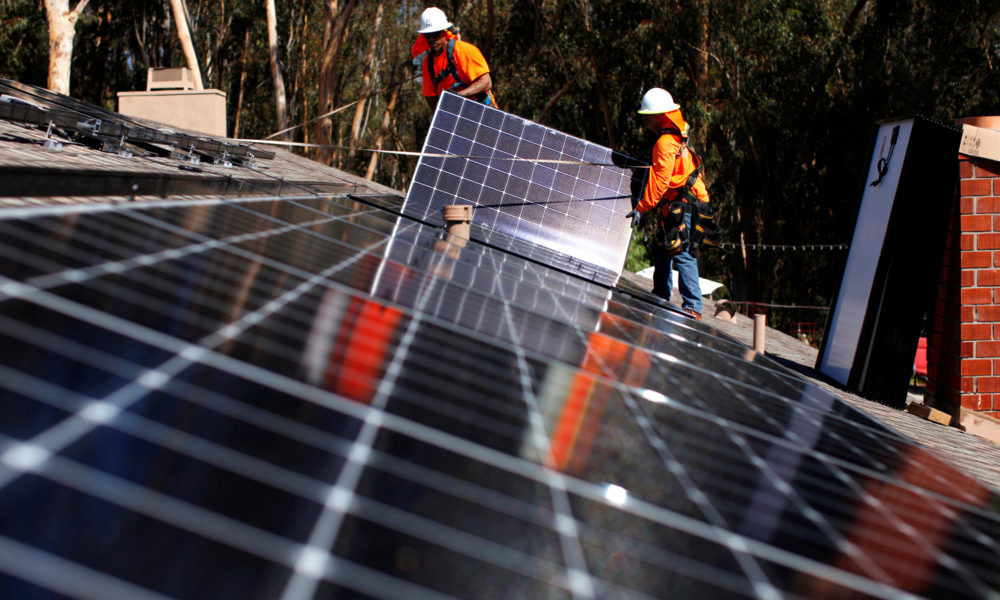As the impacts of the COVID-19 pandemic spread we must remain focused on what’s necessary in the moment: supporting healthcare workers on the front lines, doing what’s necessary to minimize the spread, and providing economic relief for affected people and businesses. Congress must lead this effort.
Congress also has the responsibility to prepare for recovery. That will mean economic stimulus to get private capital flowing again, create jobs, and move the nation forward in an equitable, responsible way—including in clean energy sectors that, like so many industries, are struggling through this crisis.
Two federal programs in particular should be part of the clean energy recovery effort: federally backed low-cost financing for clean energy infrastructure and cost-share grants for investments in a modern, clean electricity grid.
A sustained downturn in clean energy industries puts hundreds of thousands of jobs and tens of billions of dollars in investment at risk. Wind, solar, battery storage, and energy efficiency industries are all expecting significant job losses as projects are threatened by supply chain, financing, and workforce issues as a result of the COVID-19 pandemic. When we emerge from the pandemic’s immediate public health impacts, clean energy industries will need to rapidly ramp back up to get people working, support local economies, modernize our infrastructure, and keep us marching towards a truly clean and equitable energy future. Two powerful tools can help with that.
Clean energy bonds to provide low-cost financing for local clean energy investments

Investments in battery storage like this lithium-ion battery can build resiliency for critical infrastructure like hospitals while helping to integrate renewable energy resources.
First established as part of the Energy Improvement and Extension Act of 2008, New Clean Renewable Energy Bonds and Qualified Energy Conservation Bonds were designed to provide low-cost financing to city, state, and local governments or electric cooperatives and municipal utilities for investments in energy efficiency, renewable energy, mass transit, and so forth. Funding was originally set at $800 million for each program but was quickly increased by an additional $1.6 and $3.2 billion respectively in the 2009 American Recovery and Reinvestment Act (ARRA).
Though repealed by the Tax Cuts and Jobs Act of 2017, both programs would be relatively easy for Congress to reinstate and get up and running quickly. These federal bond programs are strong, proven federal tools that get money and jobs flowing into local economies.
These programs authorize local governments, municipal utilities, electric cooperatives, and other designated entities to issue bonds for a qualifying set of investments. The borrower who issues the bonds (local government, etc.) pays back the principle of the bond and the bondholder (investor that purchases the bonds) receives the paid-back principle plus a federal tax credit in lieu of traditional bond interest.
Investors find government bonds preferable (particularly during difficult economic times) because they are safe investments, backed by the government, that offer a modest rate of return through the federal tax credit in lieu of interest. The local government essentially receives zero-percent financing for qualified projects, which will be invaluable particularly as state budgets are experiencing pressure from the pandemic.
What makes this approach particularly effective is that (1) the federal government can accelerate investment in clean energy infrastructure and employment without having to foot the bill, other than the modest interest, (2) local governments are in control so can ensure investments quickly go where they are needed most, and (3) investors have access to safe investments with a guaranteed and stable rate of return.
Cost-share grants for grid modernization
In 2009, the Department of Energy launched the Smart Grid Investment Grant Program (SGIG) with $3.4 billion in funding through the ARRA. From 2010 to 2015 the program successfully provided up to 50 percent cost share to almost 100 projects nationwide that enhanced the reliability and resilience of the nation’s electric grid.
The result was $4.5 billion in private, local investments over those five years (for a total of almost $8 billion in investment) that created 12,000 direct jobs and another 35,000 full-time equivalent positions, and helped the country reach identified grid modernization targets up to four years faster than expected. These investments not only increased the reliability and resiliency of the nation’s electricity supply but also accelerated the roll-out of new technologies like advanced metering infrastructure that increases energy efficiency and renewable energy opportunities.

DOE’s Smart Grid Investment Grant Program provided cost-share grants for investments in energy infrastructure. The program led to nearly $8 billion in total investments across a range of grid modernization technologies. Source: DOE
A decade on, this successful federal structure that attracted private capital and created tens of thousands of jobs will still work—with important updates to drive the investments we need today to build resilience to increasingly extreme weather and sophisticated cyber-attacks, to improve reliability, and to decarbonize our electricity sector.
To achieve these goals, the US needs to invest in our bulk electricity transmission system to relieve congestion, update aging infrastructure, and carry new renewable energy to load. We need investments in our electric distribution systems and workforce to accommodate widespread rooftop solar and new energy efficiency and flexible demand technologies. We need investments in battery storage. And we need investment in monitoring, control, and communication technologies to keep it all running smoothly.
These types of investments – that create lasting consumer benefits while spurring economic growth and job creation – should be a primary focus of any federal stimulus and recovery legislation. These two programs can make that happen in the power sector.
Targeted federal programs to incentivize private investment and job creation
To be clear, these two programs won’t by themselves solve the current economic crisis, or the looming climate one. But they do provide solutions for Congress to implement that meet immediate stimulus needs, while advancing forward-looking and broadly beneficial investments. And they do so in a way that takes advantage of the power of private capital and economic growth.
Clean energy bonds and cost-share grant programs are powerful tools Congress has used to unleash the power of private capital to put people back to work building a cleaner, more equitable future. These tools should be part of a federal economic stimulus package.

